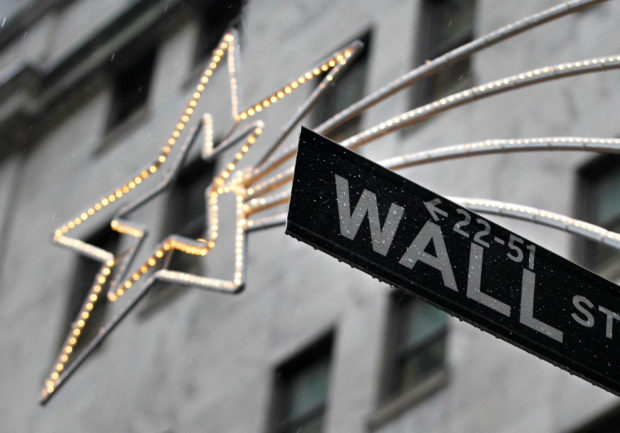
A holiday decoration is seen over Wall St. sign outside the New York Stock Exchange. REUTERS/Brendan McDermid/File photo
King Dollar’s reign (definitely) coming to an end, bonds bouncing and emerging markets rising again are just some of the trades international money managers are betting on in 2023.
Sky-high inflation and the global gut-punch of nearly 300 central bank interest rate hikes over the last 12 months are putting the focus firmly on how badly economies now buckle, and whether that forces the Federal Reserve and Co to change course.
Here are five trades investors are crowding into.
1. End of King Dollar
The dollar index, which measures the performance of the greenback against major peers, gained more than 15 percent from January to November 2022, as the Fed hiked rates aggressively.
The Fed remains hawkish, but markets are testing its resolve. Joe Little, global chief strategist at HSBC Asset Management, is tipping the dollar index to drop more than 10 percent in 2023 “based on inflation peaking and a Fed policy shift”.
The yen could also be a driving force, after the Bank of Japan sprung a late surprise by abruptly altering the “yield curve control” program it has used to keep its interest rates close to zero.
“If I had to pick one currency against the dollar, it would be the yen,” said Chris Jeffrey, head of rates and inflation strategy at Legal & General Investment Management.
2. Buy China
Investors see Chinese equities as a comeback story after a torrid few years, helped by an easing of COVID-19 restrictions, renewed focus on economic growth and shoring up the battered property market.
With COVID deaths rising again uncertainty remains, but the enthusiasm is undoubtedly there for a reopening that also eventually lifts Asian capital markets and deal-making.
MSCI’s China index gained nearly 40 percent from November to mid December but more is possible. BNP Paribas reckons travel, domestic consumption and tech shares can rise further and has upgraded China to “overweight” in its 2023 model portfolio, which includes stocks such as Tencent and Trip.com.
3. Re-emerging markets
Whisper it, but the emerging markets (EM) bulls are back after 2022 delivered some of the biggest losses on record.
With the caveat that global interest rates stabilise, China relaxes COVID restrictions and nuclear war is averted, UBS reckons EM stocks and fixed income indexes could earn between 8-15 percent in 2023 on a total returns basis.
A “bullish” Morgan Stanley expects a near 17 percent return on EM local currency debt. Credit Suisse particularly likes hard currency debt and DoubleLine’s Jeffrey Gundlach, AKA the “bond king”, has EM stocks as his top pick.
Performance following past routs underscores this wave of optimism. MSCI’s EM equity index soared 64 percent in 1999, following the Asian financial crisis, and 75 percent in 2009. EM hard currency debt saw a whopping 30 percent rebound too after its 12 percent global financial crisis drop.
4. Hello Mr. Bond
After the worst ever year for bond investors, many see a turnaround.
Inflation – the bond market’s nemesis because it forces up rates and erodes returns – looks likely to moderate this year as recessions start to bite.
Economists polled by Reuters expect headline U.S. inflation to decelerate to 3.1 percent by the end of 2023. Valentine Ainouz, fixed income strategist at the Amundi Institute, predicts the 10-year U.S. Treasury yield will end 2023 at 3.5 percent from around 3.88% currently.
Joost van Leenders, senior strategist at Van Lanschot Kempen, bought into Treasuries back in August on the expectation “inflation will come down because economic growth comes down.” He remained wary on euro zone bonds with the European Central Bank now backing out of the market and hiking rates.
5. Equities: Sell now, buy later
Equity investors hope a V-shaped year for the global economy will see stocks end it comfortably higher.
JP Morgan strategists predict “market turmoil and economic decline” to start with, but then a better second half as the Fed finally decides to “pivot”.
Hani Redha, portfolio manager at PineBridge Investments, anticipates some more downside for U.S. stocks, before a trough some time in the first half of 2023, while Royal London Asset Management’s Trevor Greetham thinks it might take longer.
“I wouldn’t be surprised if the time to buy equities is a year away or a bit longer,” he said.